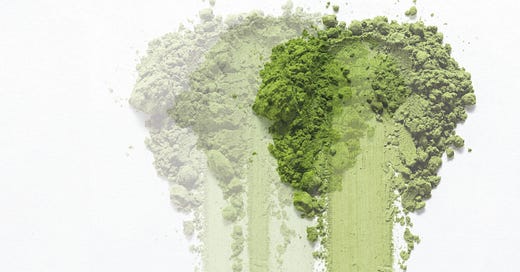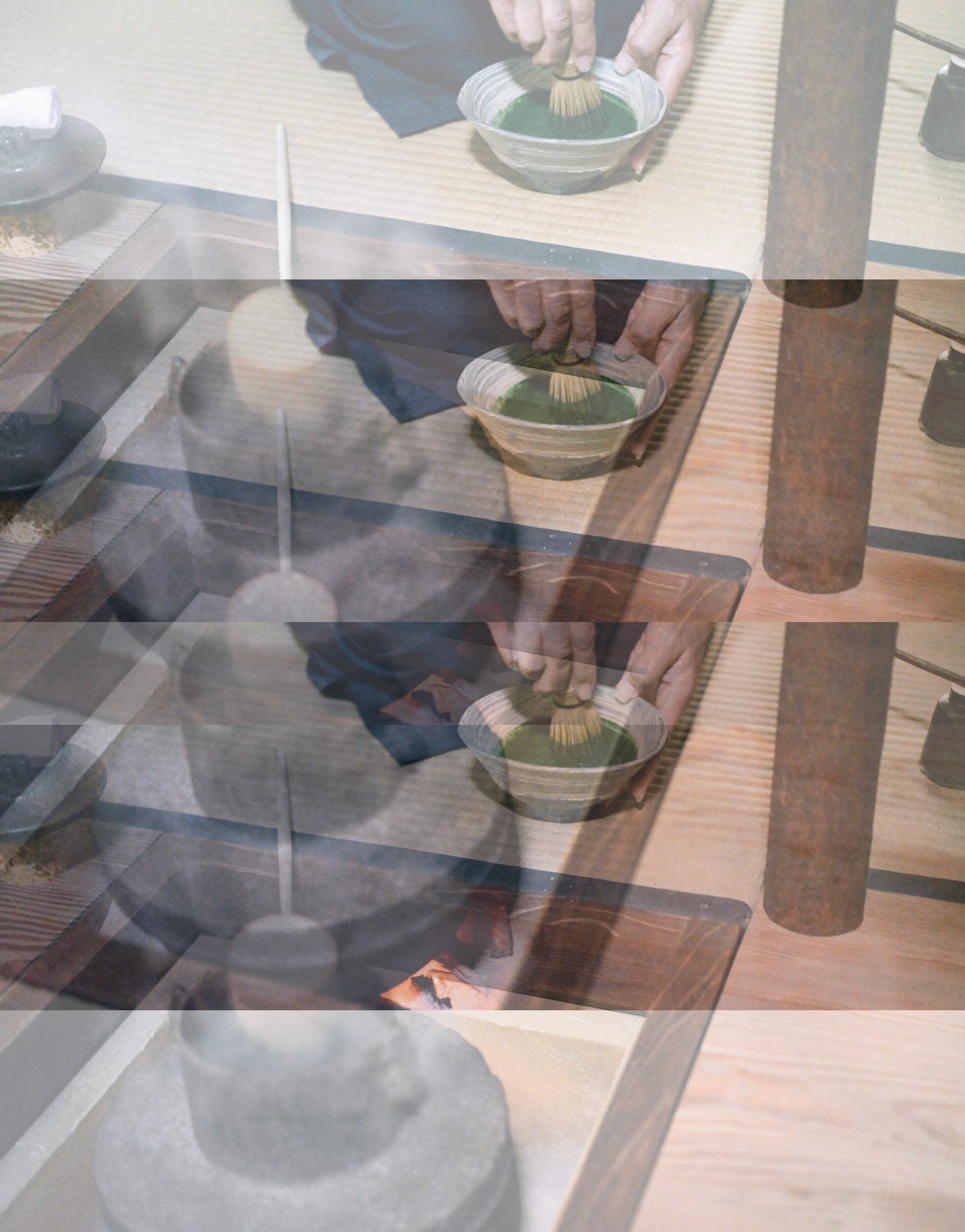You may have noticed that at Kettl we do not title our Matcha as being “ceremonial”. This is a contested decision - and from a Google SEO perspective, maybe a bad idea. Pretty much every company selling Matcha outside of Japan uses the phrase. And apparently, a lot of people use this term when searching for Matcha. And I suppose I understand why - it is a quick way to signify the purposed quality of the Matcha being sold. So I have been asking myself why I still refuse to use it? I guess to me, adding a generic term in front of a products name without providing context isn’t helpful - it’s a failure of imagination and the perfect example of jumping on the bandwagon. I don’t say this to throw shade on anyone, I understand why it is done - but I feel strongly that it does just about as much good as writing “all natural” or “artisanal” in front of store bought flour. It doesn’t actually add value or convey quality - It short circuits the customers natural desire for more information and leaves a hallow tagline in it’s place. But maybe the bigger question is: “What does the term Ceremonial mean”? Well, to be honest, it doesn’t mean anything.
It may come as a shock, but in Japan, there is no agreed upon classification for Matcha. None. The classification level only refers to Tencha - the unground form of Matcha. True Tencha must be made in a Tencha Kojo or Tencha Factory. Tencha must be shaded, but the manner in which it is shaded does not disqualify it from being labeled as Tencha. Same goes with the style of harvesting - whether hand picked or machine sheared, Tencha is Tencha if it is processed by the manner of steaming, drying, baking (Aracha) and finishing (Shiagecha). The presents a whole host of challenges - but as it stands, there is no law set of rules defining Matcha. Enter a vacuum - and vacuums loves to be filled. Please meet the term “Ceremonial”.
The origins of the term Ceremonial are not clear - although it was already being used when I began my career in Japanese tea in 2007. Matcha until only recently has been though of as almost a mystic beverage by most of the consumers in the west - connected to an even more mystical event, the “Tea Ceremony”. Tea Ceremony refers to Cha No Yu the actual event of making tea according the prescribed steps in a Japanese tea room (Chashitsu) by those studying the way of tea known as chadō. During the Cha No Yu, traditionally whisked Matcha (usucha) as well as thick kneaded Matcha (Koicha) are served. No lattes in the tea room. This, as far as I can gather is where the term originates. So in fact, it is outlining the context or style of Matcha and not a quality level. It might be surprising to hear, but many Cha No Yu gatherings in Japan are using simple, rustic styles of Matcha - not ultra premium offerings. Of course, in some cases the premiere levels of Matcha are served - but it is not always the case.
So knowing the above, the challenge now lies in finding the right way to convey quality. So what elements actually affect the the final outcome of a given Matcha. The list as I see it is as follows:
Origin of the Matcha
Cultivar of the tea
Garden Management (fertilization, pruning, shading style and duration, picking style (handpicked vs machine)
Aracha processing
Shiagecha finishing
Blending (or lack of)
Resting period
Packaging quality and storage before sale
Ok, so after looking at the long list - I kind of understand the allure of the word ceremonial. :) But! All great things require education and all of you reading this - which I truly appreciate - hopefully understand that we are in the beginning of the maturation of the Matcha market - and understanding and quantifying quality in real terms is important.
So lets discuss how we at Kettl classify Matcha.
Non-Stone Milled
Non Matcha - Milled Green Tea not from Tencha
Matcha for pastry
Stone Milled
Matcha for blending with milk (latte grade)
Matcha for whisking (usucha)
Matcha for Kneading (koicha)
Non Matcha makes up a significant amount of “Matcha” produced in Japan. It is factually not Matcha as the raw material used to produce it is not Tencha. This would be milled Sencha and Bancha. This is mostly utilized for pastry, food additives, flavorings and bottled drinks. We do not carry products of this quality level.
Matcha for pastry can run the gamut - but at its best it should stand up to the high heat of the oven, fold into butter without clumping, and the aroma should carry through with intense aromatics. We sell this grade, but only really for wholesale.
Matcha for blending with milk - a very popular style and our Hukuju remains one of our most popular products. Our latte grade is made with 1. traditional shaded Tencha and 2. milled on a traditional stone mill (ishiusu). In fact, these two factors are what we consider the combination suitable for drinking with water, yet this is where we begin our lineup. Most “latte grade” matcha is made using a ball mill or jet mill - both can produce much larger quantities - up to 80kg a day - but with a significantly less smooth texture and diminished color and flavor. Due to our incredible network of producers, we are able to offer a stone milled latte grade matcha with robust aromatics and a deeper, more verdant green color.
Matcha for whisking - this is traditionally what is called Usucha in Japan and I believe what what many people mean when they say ceremonial. Every Matcha we sell can be made as Usucha - from Soukou through to Kiwami and all of our offerings from Uji. These teas come from non pruned gardens (shizenshitate) and are hand picked. In order for a Matcha to be suitable for this level of preparation, the leaves need to be soft and higher in amino acids and free sugars which create savory sweetness, and lower in catechin which can lead to a more astringent bowl of Matcha. Additionally, good matcha has higher levels of other chemicals like saponin which helps create a creamy foam, L-arginine which creates depth and a more unctuous mouthfeel, and caffeine which provides the refreshing bite of quality Matcha.
Matcha for kneading - Many people may be unfamiliar with this style of Matcha, referred to as Koicha in Japanese. Kneaded Matcha uses half the amount of water and double the amount of Matcha powder resulting in a thick, rich buttermilk like experience that showcases the absolute pinnacle of quality Matcha. Unlike Usucha where all grades can be used, only Koicha grade Matcha can be prepared as such. Teas of this caliber contain the highest levels of L-Theanine and free sugars allowing rich, dashi like umami to develop. They also often undergo slightly longer shading and resting resulting in a deeper flavor and more verdant color. So while Koicha grade Matcha can be prepared as Usucha, the experience is generally softer and can sometimes be underwhelming the drinker - who is expecting a huge impression for the money spent on such high grade Matcha. While you don’t have to do it every time, it is worth it to try Koicha grade Matcha as Koicha to understand its intended profile.
So, my hope is that helping to understand what makes quality Matcha will make it easier to navigate shopping for quality products. It certainly is a start but a lot more work needs to be done. Developing protocols for how we evaluate, talk about and market Matcha are needed and at Kettl we feel a responsibility to participate in the process. Hashing it out in real time. So…for today, just remember, “Ceremonial” is a complex term and gives you little information about the quality of what you are buying. In my next post, I will talk more about the elements that affect quality (the list above).
Thanks for reading.
Zach











Thanks Zach. Particularly appreciate the info that "L-arginine ... creates depth and a more unctuous mouthfeel." Makes sense of some of my experiences.
Great article! I've been wondering what all this "ceremonial matcha" talk is all about. I'm learning so much from you. Keep up the great work!